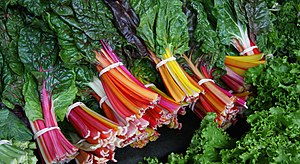Cookbook:Chard
| Chard | |
|---|---|
 | |
| Category | Vegetables |
Cookbook | Recipes | Ingredients | Equipment | Techniques | Cookbook Disambiguation Pages | Ingredients
Chard or acelga is a leafy vegetable closely related to beets.[1]
Characteristics
editChard grows as long stalks with a broad leafy section at the top resembling beet greens.[1] While the leaves are always medium-to-dark green,[1][2] the stalks and veins can come in a wide variety of colors, which has led to the term "rainbow chard".[3][4] Flavor-wise, chard is similar to other leafy greens like spinach, with a slight bitterness that mellows when cooking.[4][5] Both the stem and leaves are edible, though typically cooked separately.[5]
Seasonality
editAlthough you can often purchase chard year-round, it reaches peak season in the summer.[4]
Selection and storage
editWhen selecting chard, look for good coloration and shiny leaves, with no wilting or slimy spots.[2][4][6] Avoid brown or discolored stalks.[1] Chard will keep for a few days in the refrigerator if stored in plastic with a damp towel.[2][7] Avoid storing them with excess moisture, which can speed decay.
Preparation
editBecause the leaves and stems cook at different rates, first cut the leafy tops away from the stalks.[4][7] If cooking the stalk, trim off the tougher bottoms.
Use
editThe leaves are generally treated in the same way as spinach and the stems like asparagus or celery.[4] Fresh young chard can be used raw in salads, while older (and more bitter) chards are better off cooked to mellow them.[1] Additionally, acid and salt will help cut any bitterness.[4] Do note that the leaves will shrink significantly when cooked, so plan accordingly.[7]
Substitution
editIf you can't access chard, various other leafy greens will work as a substitute. Beet greens are particularly similar, but collard greens and spinach will also work well. Kale is tougher and more bitter but will easily work in a pinch.
Recipes
editReferences
edit- ↑ a b c d e "Would You Choose Red Chard or Rainbow Chard?". The Spruce Eats. Retrieved 2024-02-22.
- ↑ a b c "What Do I Do with Swiss Chard?". Food Network. Retrieved 2024-02-22.
- ↑ Labensky, Sarah R.; Hause, Alan M.; Martel, Priscilla (2018-01-18). On Cooking: A Textbook of Culinary Fundamentals. Pearson. ISBN 978-0-13-444190-0.
- ↑ a b c d e f g "Swiss Chard Is a Versatile and Approachable Dark, Leafy Green". Simply Recipes. Retrieved 2024-02-22.
- ↑ a b Davidson, Alan (2014-01-01). Jaine, Tom (ed.). The Oxford Companion to Food. Oxford University Press. doi:10.1093/acref/9780199677337.001.0001. ISBN 978-0-19-967733-7.
- ↑ Gisslen, Wayne (2015-03-12). Essentials of Professional Cooking, 2nd Edition. Wiley Global Education. ISBN 978-1-119-03072-0.
- ↑ a b c Thaler, Maximus; Safferstein, Dayna (2014-09). A Curious Harvest: The Practical Art of Cooking Everything. Quarry Books. ISBN 978-1-59253-928-4.
{{cite book}}: Check date values in:|date=(help)